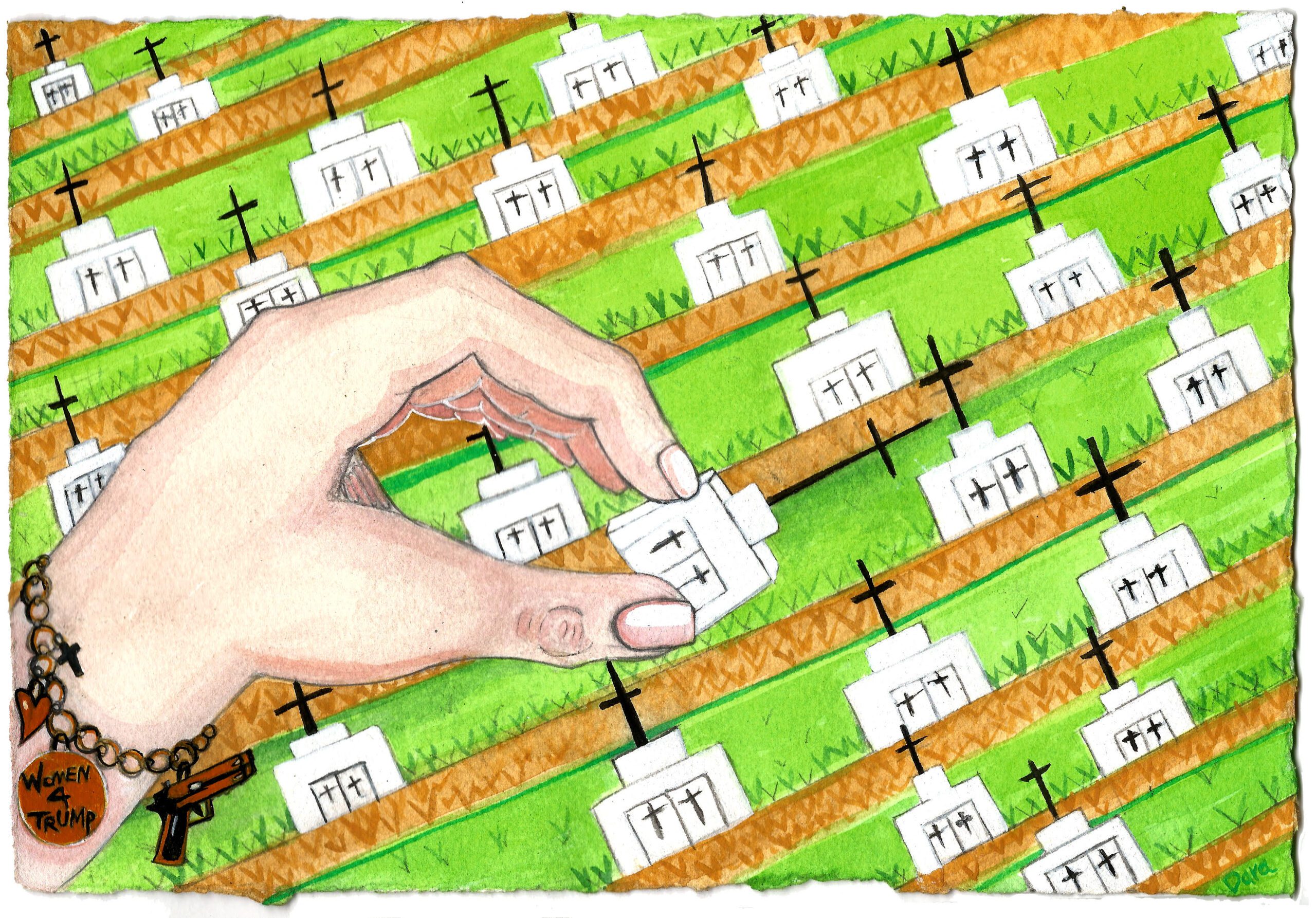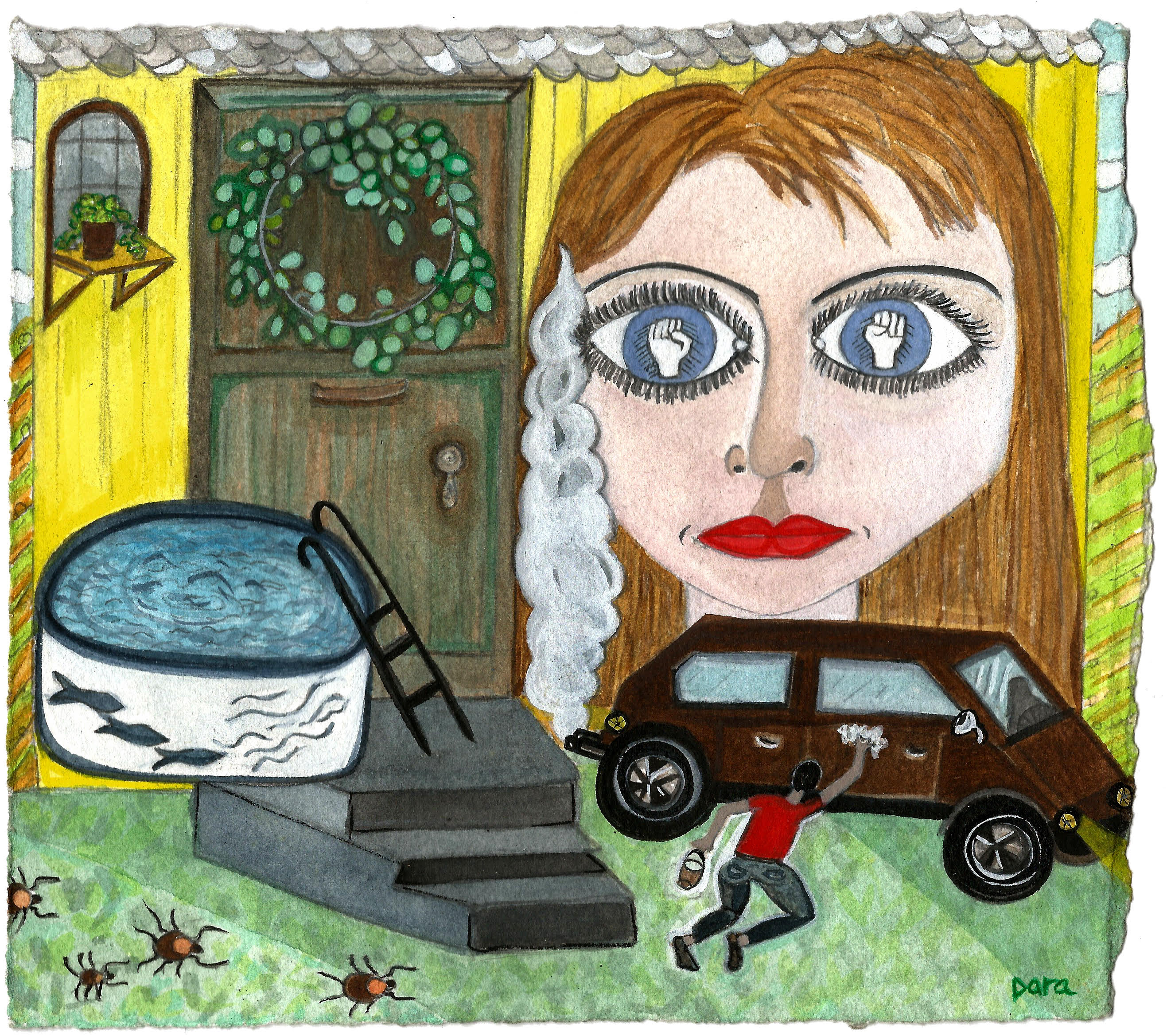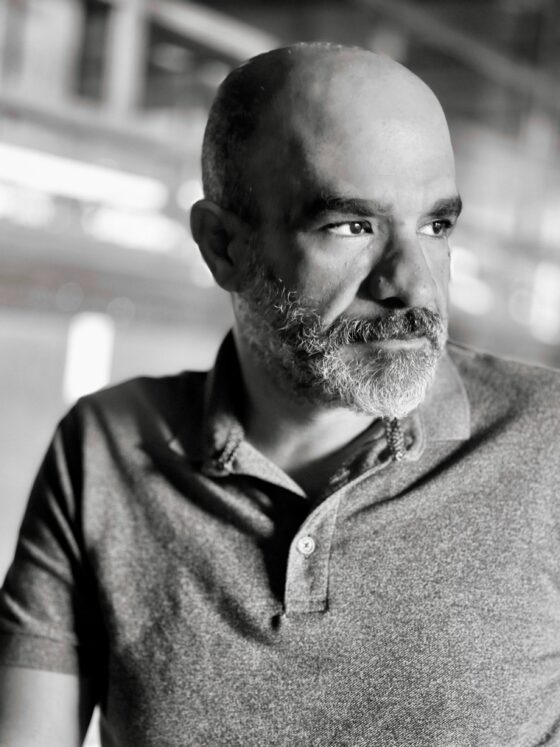
My teammate gave a firm knock on the door and stepped off the porch. I kept my eyes on the windows and rehearsed the script, turning the high points over in my head. A car engine downshifted in the street behind us, and when we turned, the driver slowed and pulled into a driveway two houses down. The blinds stayed drawn. After a minute, we returned to the sidewalk and I clicked the response on my app: “Not Home.”
Halfway up the next block, a sign reading “HOME IS WHERE THE HEART IS” was staked in the ground in front of a plain white ranch house. As we made our way up to the front porch, the first thing I noticed was an old blue bucket filled with cigarette butts, shoved beneath a plastic chair. I looked up, and on the chair’s backrest, a red sticker stared back at me: “THIS IS A TRUMP HOUSE.”
My hide rippled beneath my shirt.
Six months after the 2016 election, I began volunteering for Turn PA Blue, a grassroots organization that has been working to flip the Pennsylvania State Legislature to a Democratic majority. In the 2016 election, Chester County, Pennsylvania voted 48.8 percent for Trump, 47.6 percent for Clinton. Trump won Pennsylvania by promising coal miners that he would end the war on “beautiful, clean coal.” Pennsylvania decides presidential elections, a battleground state to its core.
Research says that the best way to reach undecided voters is by showing up at their doors, so at the beginning of September, I slathered on sunscreen and a fedora and carpooled to our meetup, a shopping center forty minutes from my house in Philadelphia. We drove over rolling green hills past Valley Forge National Park to the heartland of Women for Trump.
The meeting place turned out to be a trendy, renovated factory building that rents office space to two churches. Just inside the entrance, church members milled around outside a large meeting room drinking coffee, kids goofing at the edges. An electronic message board flashed off and on again, and was replaced by the words, “Are Democrats Doomed?”
“Seed-planting” is a term used by Evangelical Christian churches to describe the process of “expanding Christ’s kingdom through planting churches that plant churches.” It’s part of an end-times commitment to saving souls before The Rapture comes for the true believers, who will “rise in the clouds, to meet the Lord in the air” (1 Thessalonians 4:17). For years, my liberal parents would play The Rapture. Dad would go into the kitchen looking for coffee and find my mom’s pajamas and slippers in a pile on the floor. Raptured while baking.
A man in a white button-down shirt and tie called out: “Alright now, everyone, let’s bow our heads!” People stopped in their tracks and looked at their shoes. “Please, Lord Jesus, we just ask that in the year ahead, you watch over our children and protect them from—” here, the man paused, “people.”
“Is this our demographic?” I whispered to another volunteer.
“Probably not?” She shrugged. “For the past few months, we’ve been pretty much focused on talking to Democrats. These are just get out the vote visits.”
I checked my phone to make sure MiniVAN was working, a canvassing app that replaces paper lists and clipboards with electronic lists of voters and an interactive map. Once the campaign literature was handed out, a staffer called out our assignments: “Okay, everybody, thanks so much for coming out! Today, we’re going to be focusing on Rs, Is and Os.”
Republicans, Independents, and Others.
Swing voters.
At the third house, a dog barked and lunged at the other side of the door. When the sixth finally opened, my teammate Melanie introduced herself and our reason for knocking. “Hi, we’re just stopping by to let you know that we’ve got some great local candidates on the ballot on November 5. Are you planning to vote?” The man gave a vague nod, took the campaign flyer, and closed the door.
A silver car with black tinted windows was parked in the driveway at the end of the block. My ears perked at a “COEXIST” sticker on the left bumper, but the right side was marked with a green and white faux Starbucks logo and the words “GUNS AND COFFEE.” Beneath it, another sticker read “PRO GUN/ANTI-LIBERAL.”
My heels splintered with the urge to march up the driveway and jam my thumb against the bell. If Melanie felt it too, she only waved. “Let’s skip this one. I’m not looking for an argument.”
Before fleeing upstate New York in my early twenties, I spent weekends in anti-war protests, volunteering for GreenPeace, arms linked with friends in AIDS marches. From Monday through Friday, I was a third grade teacher living under the daily fear of being outed.
In every story I read to my class, the villains were my student’s uncle, who recognized me at a club, kissing a girl. He got in my face and screamed and spit and called me disgusting. At parent-teacher conferences the next week, the girl’s parents glared at me with their arms folded, finally shouting what are you teaching our daughter, without saying what they knew. I shook next to the principal, certain that I was about to be outed, arrested or fired.
When that didn’t happen, I decided it was time for my third graders to learn about activism. I wanted to find out what mattered to eight-year-olds.
“Pollution,” said one student. The others nodded gravely, their small faces pale and serious. “Trash is bad.”
“Endangered species,” said another. “We could adopt a whale!”
This got them excited. Their own creature to care for. I promised that I would find the information needed to help, and we would come up with a plan.
Ultimately, they decided on manatees, sweet baby elephants of the sea. The class raised enough money to adopt Lucky, a four-year-old female who had been spotted in the warm, slow-moving waters of the Florida Keys. The rescue center sent us a detailed diagram of Lucky’s injuries: a propeller mark on her left side, a deep slash across her back, a missing piece of flipper.
The class giggled when they discovered that the name manatee comes from the Taíno people of the Caribbean islands, manatí, meaning “breast.”
A boy asked, “What happened to them?”
I cocked my head. “The manatees?”
“No, the people.”
The class waited. I looked at them carefully, weighing what I thought I knew against what has been buried. What I know now: after welcoming Columbus and his men to the Caribbean, Taíno men were murdered or beaten and shipped across the sea to work in gold mines. Within twenty years, forty percent of the women were married to conquistadors. With no one left to plant the crops, people began to starve. Those who weren’t killed by European diseases fled or committed suicide. Within fifty years, three million people were gone.
How do you explain this to a third grader?
“A disease called smallpox,” I said finally, “and slavery.”
After leaving upstate New York, for ten years I walked the halls of Congress in pointy heels, talking about public education reform. I’ve experienced firsthand that talking to a Republican Senator face to face can turn a No into a Yes, or at least a solid “I’m going to give this some more thought.”
I’m a good talker, but the first time I went canvassing, I was squirrelly. Showing up at people’s houses on a Sunday to talk about their politics brought me back to the frightened self I have worked so hard to shed.
In a 2015 survey from Pew Research Center, only twenty-eight percent of white Evangelical Christians believe global warming is due to human activity, compared to seventy-seven percent of Latinx Evangelical Christians and fifty percent of all US adults. Professor Emma Frances Bloomfield suggests three communication strategies when talking with people who believe that climate change is a threat to their faith: 1) treat conversations as dialogues; 2) locate common values; and 3) avoid relying on science.
This is what Full Frontal with Samantha Bee correspondent Allana Harkin did when she traveled to Tangier Island, a small island off the coast of Virginia that has lost two-thirds of its land mass since the 1850s. Many of the residents are Evangelical Christians, so when talking to them about climate change, Harkin tried this: “Let me throw this out there, and we’ll let it land. We won’t even have to discuss it. What if climate scientists are actually doing God’s work?”
The room was silent. Stunned.
“He works through everybody,” said one man, finally.
“Yeah, He can work through them,” said another, nodding.
My first solo knock was a neat ranch house the color of lemon chiffon pie with a eucalyptus wreath over the knocker. As I walked up the driveway, I decided that I would focus on an issue that everyone could get on board with—clean drinking water and more green spaces. Who doesn’t love parks?
I gave the door a rap, and after a long minute, a woman opened the door. I offered my most congenial smile and said, “Hi, I’m out talking to voters today to remind them about the upcoming election. Do you have a few minutes?”
The homeowner stepped onto the porch and closed the door behind her. Behind her thick lashes, the woman’s eyes were a watery cornflower blue. “Thank you for what you’re doing,” she said, her voice low.
“Thanks for opening the door,” I chuckled, because I might not have done the same.
Her eyes darted at the living room window and back to meet mine, and that’s when I understood that she was afraid. One of the volunteers said that this is how many of the women in Chester County react, that talking to Democrats is a kind of betrayal. “What you’re doing is really important,” she affirmed, and looked me in the eye. “I’m grateful.” She took one of my campaign flyers and ducked back inside.
The sun was bright, the air buzzed with the sound of mowers. I slugged some water, took a look around. An air conditioner rattled in a window. Two kids on bikes. A guy in a madras shirt, washing a minivan. A teenager driving a minivan. A plastic pool.
When I knocked on the last door, a young woman stood in the kitchen in yoga pants pulling laundry from the washing machine, and I saw myself, had I chosen a different life. I knocked softly, and when she saw me, the woman looked around the room like she was looking for backup. A football announcer shouted in the background. She sighed and put down the laundry basket and spoke to me through the screen.
“Can I help you?”
When I told her why I was there, her face was blank. I gestured toward the yard, which was heaped with toys and plastic scooters. “You’ve got kids?” I smiled.
She nodded. “Three.”
“So our candidate for City Commissioner is a parent, too. She’ll put policies in place that will keep pipeline companies out. She believes in solar energy and creating more green spaces.” I paused. “Basically, she wants to make sure that your grandkids still have green grass and clean water.”
The woman pointed to my campaign flyer. “Which party?”
I could have told her about the survey that showed that seventy-seven percent of Generation Z and Millennial Republicans believe that climate change is a serious threat, one percentage point higher than Democrats of the same age. Or that whole countries are ending their investments in fossil fuels. It’s been two years since the Trump administration began rolling back environmental policies, but federal data shows that as a result of the decreased international demand for coal, in 2018, the amount of coal mined in the US dropped to its lowest level in forty years.
Across the globe, indigenous communities are the leaders in this revolution. And they are dying for it. In 2018, more than three people died every week defending our environment.
When Trevor Noah interviewed activist Greta Thunberg about climate change, he asked her, “What do you think that people should do?” Without missing a beat, Thunberg responded, “If were to choose one thing everyone would do it would be to inform yourself and to try to understand the situation, and try to push for a political movement that doesn’t exist, because the politics needed to fix this doesn’t exist today.”
“Democrat,” I said.
The woman clicked open the door and slid her hand through the crack. “I’ll take one.”
At home, I feel stretched inside, hopeful in a way that I can’t name just yet. There are still a few more hours of sun, so I grab a book and flop down in the backyard with my wife and our dog. When the sun cools, we curl up on the bed, and I open my laptop to read the news.
I don’t say anything when the first speck wobbles across the screen. Twenty seconds later, a period dislodges itself from the end of a sentence and marches toward the keyboard.
I lean in and squint. “What is that?”
“Tick,” my wife nods. “I saw it, too. Is it a tick?”
We look at the dog. I get up and peer at the curved ridge of his back. Within seconds, I see them: tiny dots of pepper weaving in and out of his white fur. I shriek ohmygod! and he yelps awake, but I’ve already got him under my arm like a football, sprinting for the back door. “Get the hose!”
We comb our fingers through his wet fur. There are dozens, maybe hundreds of mili-specks crawling across his belly and under his collar and inside the tender flaps of ear cartilage. I look down in time to see one speeding toward the edge of my cut-offs and no-no-no pinch it between my thumb and index finger, hard. It takes three more tries before the critter stops moving.
It isn’t until I look at my wife’s face that I can feel my own fear.
In Porochista Khakpour’s memoir, Sick, she wrote that approximately thirty thousand cases of Lyme Disease are reported to the CDC each year: “Over the past sixty years, the number of new cases per decade has almost quadrupled; the number of outbreaks each year has more than tripled since 1980.” I have a friend whose face has become palsied, joints swollen and nerves firing at random, from Lyme. Another whose eyes are so vulnerable to light that she must wear sunglasses inside, even at night.
After an engorged adult female tick drops off the host, she lays several thousand eggs and dies. Before a newly hatched larva can enter the next stage in its life cycle, it must have its first blood feast.
“How many legs?”
“Six,” I tell the vet tech over the phone, ready to bite my hand, to stop it from wanting to scratch. “Maybe they’re mites?”
We text two pictures and a video, then we fill an old stainless steel washing tub with warm, soapy water. We run our fingers through the dog’s fur, swirl the water with our hands, and wait for the bugs to float.
Central air purring through my window. A guy in a Talking Heads shirt, watering his hedge. A teenager driving a minivan. A plastic pool.
Al Gore was right—global warming is inconvenient as hell.
Six years ago, I lost most of my possessions after my first wife died from cancer, but I have replaced many of these things, one Amazon box at a time. What if climate denial is just a byproduct of years of evolution? If you can’t see danger, if you can’t hear or smell it, then what? Time for a nap.
When the turn of the century Philadelphians expanded the city’s borders in search of fresher air, the Leni Lenape’s northeastern woodlands were razed to create pastures. Soon the pastures became houses and factories, but the deer remained. Not far from my home, Wissahickon Creek, Lenape for “catfish stream,” flows through twenty-three miles of urban park. This area is a carbon dioxide-sucking, yet increasingly humid climate, perfectly situated to breed Lyme-bearing ticks.
I stare out at the grass, contemplating extinction.
That’s when we get the call back. “Seed ticks,” the vet tech says. “Baby deer ticks. Sometimes dogs will run into a pile of larvae that have just hatched. You’re in for a long night.”
After I hang up the phone, I realize that I’ve forgotten to ask whether baby ticks carry Lyme.
If you haven’t lived through a California wildfire or a Texas flood or a Louisiana hurricane, it’s easy to assume that you’re safe , but once you start looking, the signs are everywhere. Twenty minutes from my front door is a town that is rapidly being acknowledged as a cancer cluster. Fifteen minutes in the other direction is another town that once boasted being the Asbestos Capital of the World. In the 60s and 70s, kids would ride flattened cardboard boxes down 1.5 million cubic yards of asbestos-contaminated waste, known locally as the “White Mountains of Ambler.” From 2000-2014, Montgomery County ranked eleventh out of 726 counties in the nation with the most deaths from mesothelioma and asbestosis.
Whether it’s traveling through our groundwater or hidden in plain sight, the evidence is there: cancer doesn’t care about how you vote.
This is why Saint Greta, in all of her wisdom, is leading the way. At sixteen, she understands that we’re beyond talking about recycling. This is not about one plastic bottle or a planted tree. This is about whole continents choosing to divest of fossil fuels. Activists and artists and educators working with scientists and evangelicals and architects and engineers to find solutions to turn this around before it’s too late. All great movements are the result of a paradigm shift. We need a sea change.
We’ve got them on the run now. After five hours of tweezing and smushing, the last stragglers seem to be gone. The vet says the tick prevention medicine will poison any larvae we haven’t gotten within twenty-four hours. The dog is safe. As for us, whatever unseen things have burrowed into our skin will remain until they fall. This is the success of parasitic relationships—they have adapted so that the decay can go unnoticed, allowing parasites to feed from the host invisibly, even indefinitely.
“YES!” I scream, when Google finally spits out the news: seed ticks don’t carry Lyme.
If a larva’s first blood feast is from a Lyme-free host, it molts into an eight-legged Lyme-free nymph, and the nymph feasts and sheds and becomes a Lyme-free, egg-bearing adult. At every point in its life cycle, a tick feasts and molts and feasts and sheds and feasts again. Whatever we feast upon, we become.
And that’s the trick, isn’t it? If we continue to believe the narrative that we are doomed, how is that any different than waiting to be raptured? Poet Lyla June Johnston urges us to love deeper: “Diversity is having a seat at the table. Decolonization is breaking the table apart and inviting everyone in.” That I am a gay woman writing and voting from the home I own with my legal wife is proof that change happens when we abandon the script. We are endlessly imaginative beings. Nature finds solutions. We can metamorphose into a wholly new species in which the collective creative power to save ourselves belongs to us.
***
Rumpus original logo by Abbey Ryan. Additional original artwork by Dara Herman Zierlein.
***
TURNING PURPLE believes that the personal is always political. Leigh Hopkins writes this column for The Rumpus with the goal of acknowledging the rage many of us feel while confronting the borderland between right and left, red and blue. Send us a note about the issues that most challenge you, or reach out to Leigh on Twitter and she may include your stories in future pieces.







